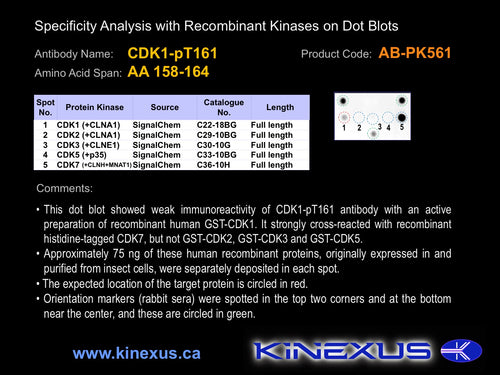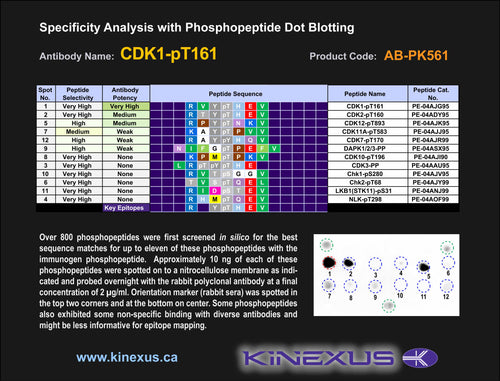Product Name:
CDK1-pT14+pY15
Product Number:
ab-pk561
Target Full Name: Cyclin-dependent protein-serine kinase 1; Cell division control protein 2 homologue
Target Alias: Cdc2; CDC28; CDC28A; CDC2A; Cell division control protein 2; Cell division cycle 2, G1 to S and G2 to M; Cyclin-dependent kinase 1; P34 protein kinase; Kinase Cdc2; MPF; DKFZp686L20222; MGC111195; ENSG00000170312
Product Type Specific: Protein kinase phosphosite-specific antibody
Antibody Code: PK560
Antibody Target Type: Phosphosite-specific
Antibody Phosphosite: T14+Y15
Protein UniProt: P06493
Protein SigNET: P06493
Antibody Type: Polyclonal
Antibody Host Species: Rabbit
Antibody Immunogen Source: Human CDK1 (CDC2) sequence peptide Cat. No.: PE-04ACM99
Antibody Immunogen Sequence: EG(pT)(pY)GVV(bA)C
Antibody Immunogen Description: Corresponds to amino acid residues E12 to V18; In the protein kinase catalytic domain in subdomain I.
Production Method: Corresponds to amino acid residues E12 to V18; In the protein kinase catalytic domain in subdomain I.
Antibody Modification: Protein kinase phosphosite-specific antibody
Antibody Concentration: 1 mg/ml
Storage Buffer: Phosphate buffered saline pH 7.4, 0.05% Thimerasol
Storage Conditions: For long term storage, keep frozen at -40°C or lower. Stock solution can be kept at +4°C for more than 3 months. Avoid repeated freeze-thaw cycles.
Product Use: Western blotting | Antibody microarray
Antibody Dilution Recommended: 2 µg/ml for immunoblotting
Antibody Potency: Very strong immunoreactivity of a target-sized protein by Western blotting in immmature sea star oocytes. Very strong immunoreactivity with immunogen peptide on dot blots.
Antibody Species Reactivity: Human
Antibody Positive Control: The observed molecular mass of the processed target protein on SDS-PAGE gels is reported to be around 30-35 kDa.
Antibody Specificity: Medium-High
Antibody Cross Reactivity: In HEK-293 cells, phenylarsine oxide (PAO) decreases 50 kDa + 30 kDa proteins; in Jurkat cells, phenylarsine oxide (PAO) increases 15 kDa protein and very weakly many other proteins.
Related Product 1: CDK1-pT14+pY15 blocking peptide
Related Product 2: CDC2-CT (CDK1-1) pan-specific antibody (Cat. No.: AB-NK025-4)
Related Product 3: CDK1-X pan-specific antibody (Cat. No.: AB-NK025-7)
Related Product 4: CDK1-pT14 phosphosite-specific antibody (Cat. No.: AB-PK559)
Related Product 5: CDK1-pY15 phosphosite-specific antibody (Cat. No.: AB-PK562)
Related Product 6: CDK1-pY19 phosphosite-specific antibody (Cat. No.: AB-PK563)
Related Product 7: CDK1-pT161 phosphosite-specific antibody (Cat. No.: AB-PK561)
Related Product 8: CDK1-3 Selectide - CDK1 (CDC2) protein kinase substrate peptide
Related Product 9: RNA polymerase II-CT KinSub - heptapeptide repeat from C-terminus peptide; CDKtide protein kinase substrate peptide
Scientific Background: CDK1 (CDC2) is a protein-serine/threonine kinase of the CMGC group and CDK family. It plays an essential role in cell cycle control in eukaryotic cells by regulating the centrosome cycle, mitotic onset, G2-M phase transition, G1 progression, and G1-S phase transition through an association with various interphase cyclin proteins. Phosphorylation events at T14 or Y15 on the protein are inactivating, while phosphorylation at T161 is stimulatory. CDK1 appears to be a tumour requiring protein (TRP). Gain-of-function mutations in the CDK1 gene have been linked to several forms of cancer, indicating an oncogenic role for the CDK1 protein. Cells transformed with the oncogene MYC undergo apoptosis when treated with small-molecule CDK1 inhibitors. Elevated expression of CDK1 has been reported as a diagnostic marker for cancer progression in esophageal adenocarcinoma, potentially reflecting the role of the CDK1 protein in tumourigenesis. CDK1 expression can be used as a prognostic indicator for early breast cancer. For example, breast cancer tumours with high expression of CDK1 are correlated with a significantly lower 5-year patient survival rate (66. 9%) than tumours that have low levels of CDK1 expression (84. 2%).




